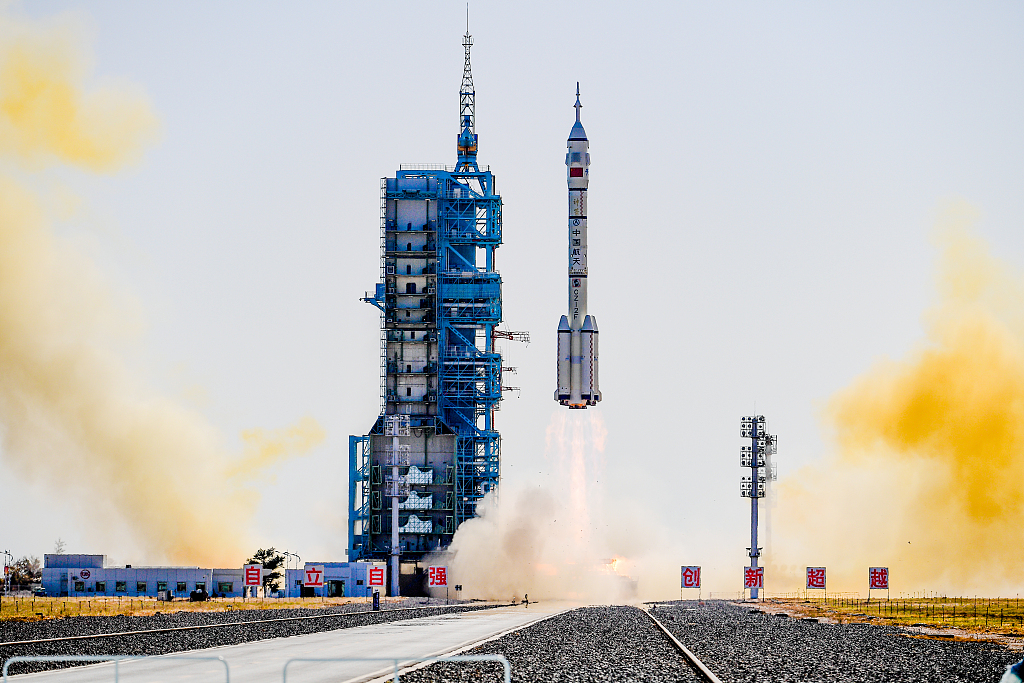 The Long March-2F carrier rocket carrying the Shenzhou-17 spacecraft blasts off from the Jiuquan Satellite Launch Center in northwest China, October 26, 2023. /CFP
The Long March-2F carrier rocket carrying the Shenzhou-17 spacecraft blasts off from the Jiuquan Satellite Launch Center in northwest China, October 26, 2023. /CFP
The Long March-2F carrier rocket carrying the Shenzhou-17 spacecraft blasts off from the Jiuquan Satellite Launch Center in northwest China, October 26, 2023. /CFP
China’s Shenzhou-17 taikonauts have successfully concluded their six-month journey and are returning to Earth on Tuesday. The trio is known as the country’s youngest lineup by average age, with Commander Tang Hongbo at 48, Operator Tang Shengjie at 34 and Operator Jiang Xinlin at 35, since the China Space Station (CSS) construction began, according to the China Manned Space Agency.
The Shenzhou-17 mission is the second manned spacecraft launched by China last year after the Shenzhou-16 manned spacecraft, marking the 30th flight mission of China’s manned space program and the 12th manned mission of the program.
The Shenzhou-17 crew carried out two extravehicular activities, completing China’s first-ever extravehicular repair mission. The trio have also carried out 84 in-orbit experiments and tests for space application, producing more than 200 samples in multiple fields, such as space life science and biotechnology, space medicine and space material science. The crew will deliver the samples for scientific studies, potentially leading to significant scientific advancements.
 CGTN graphics by Yin Yating.
CGTN graphics by Yin Yating.
CGTN graphics by Yin Yating.
The mission logo
The logo of the Shenzhou-17 manned mission was released last March along with the mission logos of the Shenzhou-16 manned mission and the Tianzhou-6 mission. It was the first open logo solicitation of China’s manned space program.
The Shenzhou-17 logo is designed by Tan Haoyu, a postgraduate student at Sichuan Fine Arts Institute. It has a balanced composition with the forward docking port of the spacecraft shown in the center. The tail flame of the spacecraft is combined with the number “17,” producing a powerful visual impact symbolizing the vigorous development of China’s manned space program.
 The logo of the Shenzhou-17 manned space mission. /China Manned Space Agency
The logo of the Shenzhou-17 manned space mission. /China Manned Space Agency
The logo of the Shenzhou-17 manned space mission. /China Manned Space Agency
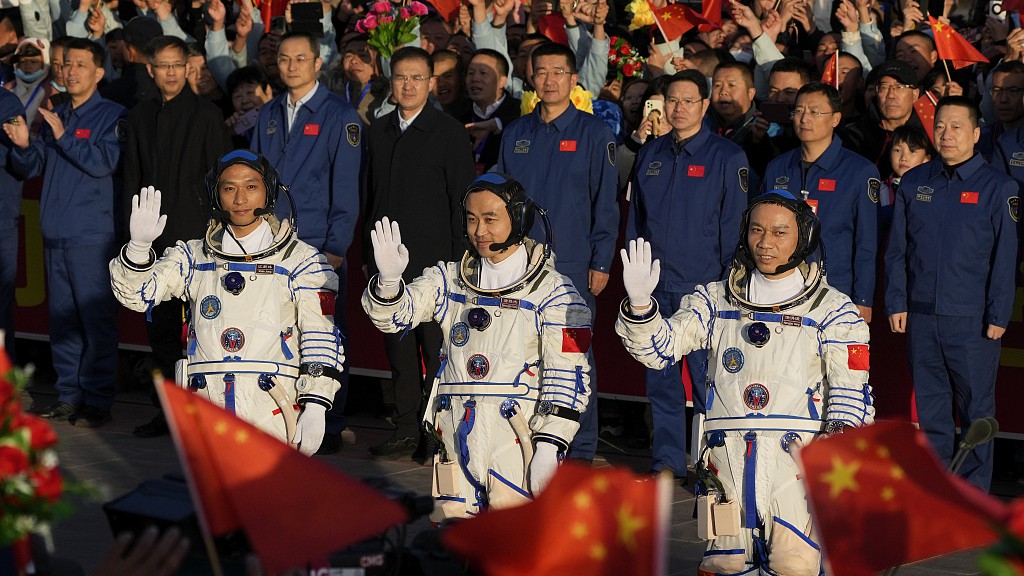 A send-off ceremony for the Shenzhou-17 crew held at the Jiuquan Satellite Launch Center, October 26, 2023. /CFP
A send-off ceremony for the Shenzhou-17 crew held at the Jiuquan Satellite Launch Center, October 26, 2023. /CFP
A send-off ceremony for the Shenzhou-17 crew held at the Jiuquan Satellite Launch Center, October 26, 2023. /CFP
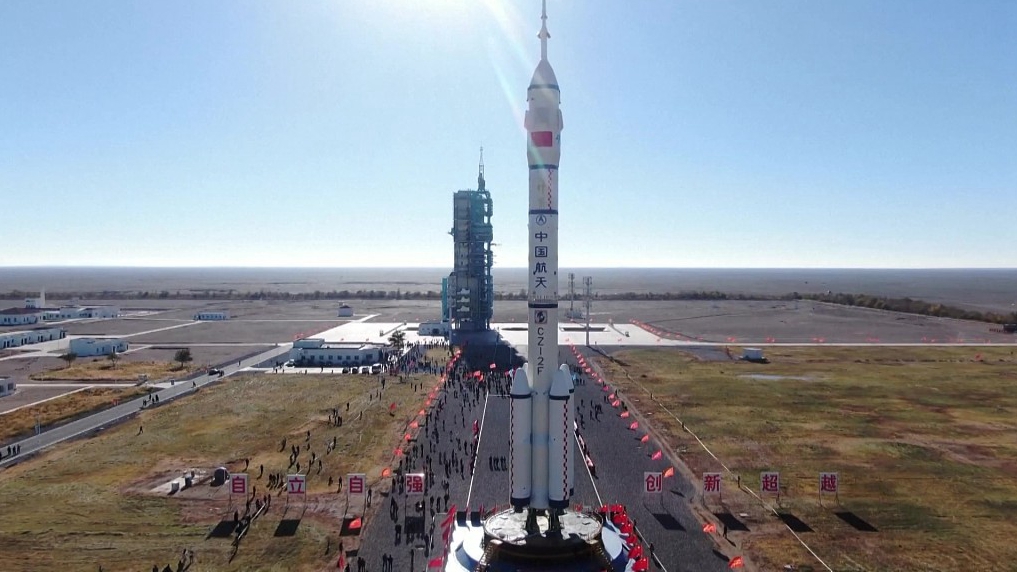 The combination of the Shenzhou-17 manned spaceship and a Long March-2F carrier rocket was transferred to the launching area at Jiuquan Satellite Launch Center in northwest China, October 19, 2023. /CFP
The combination of the Shenzhou-17 manned spaceship and a Long March-2F carrier rocket was transferred to the launching area at Jiuquan Satellite Launch Center in northwest China, October 19, 2023. /CFP
The combination of the Shenzhou-17 manned spaceship and a Long March-2F carrier rocket was transferred to the launching area at Jiuquan Satellite Launch Center in northwest China, October 19, 2023. /CFP
The rocket and spacecraft
The Shenzhou-17 manned spacecraft was sent into space onboard a Long March-2F carrier rocket. The rocket measures about 60 meters in length and over 3 meters in diameter. It is equipped with four boosters and has a takeoff weight of around 480 tonnes.
The rocket is a remarkable feat of technology. Compared with the rocket used for the previous missions, Chinese space engineers have made a total of 25 technical changes, mainly improving reliability and safety, and optimizing the whole working process at the launch site.
The Shenzhou-17 manned spacecraft consists of three modules: the return, the orbital and the propelling modules. It is the second of the new batch of the Shenzhou series, which started with the Shenzhou-16 manned spacecraft.
Compared with previous batches, the current batch has seen qualitative leaps in design and production, including using domestically made key components that make the spacecraft more independent and controllable.
 The six taikonauts of Shenzhou-16 and Shenzhou-17 hug in the airlock module of the China Space Station. /China Manned Space Agency
The six taikonauts of Shenzhou-16 and Shenzhou-17 hug in the airlock module of the China Space Station. /China Manned Space Agency
The six taikonauts of Shenzhou-16 and Shenzhou-17 hug in the airlock module of the China Space Station. /China Manned Space Agency
 Two teams of six taikonauts show thumbs up in the core module of the China Space Station for a group photo. /China Manned Space Agency
Two teams of six taikonauts show thumbs up in the core module of the China Space Station for a group photo. /China Manned Space Agency
Two teams of six taikonauts show thumbs up in the core module of the China Space Station for a group photo. /China Manned Space Agency
Entering the China Space Station
The Shenzhou-17 taikonauts entered the China Space Station last October, starting a new round of in-orbit handover with the Shenzhou-16 taikonauts.
The spaceship made a fast, automated rendezvous and docked with the front port of the space station’s core module Tianhe on the same day, according to the China Manned Space Agency. The Shenzhou-16 crew opened the hatch of the airlock module and welcomed the Shenzhou-17 crew with hugs. Later on, they entered the core module of the space station.
The two crew teams took a group photo and sent their best wishes to Earth.
Shenzhou-17 crew commander Tang was one of the first taikonauts to enter the newly-built CSS in 2021 and returned only two years later to see how the station has expanded from one module to three. This makes him the Chinese taikonaut with the shortest interval between two missions by far.
 The Shenzhou-17 crew conducts extravehicular experimental maintenance, December 21, 2023. /China Manned Space Agency
The Shenzhou-17 crew conducts extravehicular experimental maintenance, December 21, 2023. /China Manned Space Agency
The Shenzhou-17 crew conducts extravehicular experimental maintenance, December 21, 2023. /China Manned Space Agency
First extravehicular experimental maintenance
The tasks of the Shenzhou-17 crew included extravehicular activities, space science experiments and technological tasks, routine work of platform management and space lectures.
Among their tasks, the Shenzhou-17 crew undertook a “very challenging task” for the first time: extravehicular experimental maintenance.
Ahead of the mission, Liang Guozhu, professor at the School of Astronautics of Beihang University, told China Media Group that “there will be some small scratches outside the space station due to the impact of space debris. Though such scratches were considered when designed, we still need to perform regular maintenance to ensure the long-term use and service life of the space station, just like cars.”
During the 7.5-hour-long extravehicular activity, Shenzhou-17 commander Tang Hongbo along with crew members Tang Shengjie and Jiang Xinlin cooperated closely with the ground staff and used robotic arms to complete repairing the solar panels on the core module of the space station.
Commander Tang made his second spacewalk after two years. Meanwhile, Tang Shengjie became the youngest taikonaut in China’s history to carry out spacewalks.
 The Shenzhou-17 manned spacecraft docks with the China Space Station, October 26, 2023. /China Manned Space Agency
The Shenzhou-17 manned spacecraft docks with the China Space Station, October 26, 2023. /China Manned Space Agency
The Shenzhou-17 manned spacecraft docks with the China Space Station, October 26, 2023. /China Manned Space Agency
Invitation to foreign astronauts
China has extended an invitation to the world, welcoming countries and regions committed to the peaceful use of outer space to collaborate in CSS missions, as stated by the China Manned Space Agency.
This indicates that the normal operation of CSS has reached a very high level, according to Liang.
“The main goal of China’s space program is to make peaceful use of space, and the exploration of space is the dream of all mankind. Therefore, we hope that astronauts from other countries can participate in our work to jointly develop space resources, strengthen international cooperation and promote the development of a human space community,” said Liang.
Check out the life of Shenzhou-17’s crew in space
 The Shenzhou-17 crew celebrate the 2024 Chinese New Year in space. /CMG
The Shenzhou-17 crew celebrate the 2024 Chinese New Year in space. /CMG
The Shenzhou-17 crew celebrate the 2024 Chinese New Year in space. /CMG
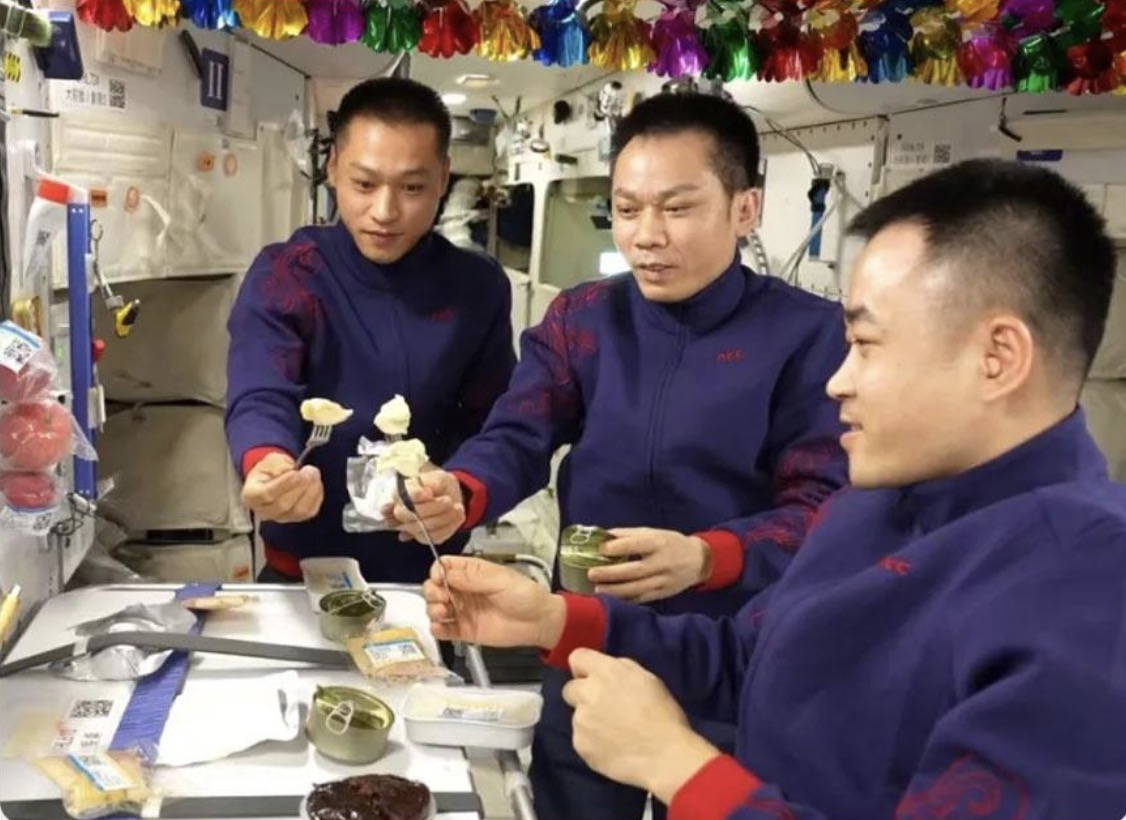 The Shenzhou-17 crew eat Chinese dumplings (Jiaozi) to celebrate the 2024 Chinese New Year in space. /CMG
The Shenzhou-17 crew eat Chinese dumplings (Jiaozi) to celebrate the 2024 Chinese New Year in space. /CMG
The Shenzhou-17 crew eat Chinese dumplings (Jiaozi) to celebrate the 2024 Chinese New Year in space. /CMG
 The Shenzhou-17 crew eat vegetables grown in China’s space station. /CMG
The Shenzhou-17 crew eat vegetables grown in China’s space station. /CMG
The Shenzhou-17 crew eat vegetables grown in China’s space station. /CMG
 The Shenzhou-17 crew get haircuts in space. /CMG
The Shenzhou-17 crew get haircuts in space. /CMG
The Shenzhou-17 crew get haircuts in space. /CMG
 A view of Earth captured by the Shenzhou-17 crew. /CMG
A view of Earth captured by the Shenzhou-17 crew. /CMG
A view of Earth captured by the Shenzhou-17 crew. /CMG
 A view of space captured by the Shenzhou-17 crew. /CMG
A view of space captured by the Shenzhou-17 crew. /CMG
A view of space captured by the Shenzhou-17 crew. /CMG
 A view of Earth captured by the Shenzhou-17 crew. /CMG
A view of Earth captured by the Shenzhou-17 crew. /CMG
A view of Earth captured by the Shenzhou-17 crew. /CMG
 A poster of the Shenzhou-17 crew (L-R) Tang Shengjie, Tang Hongbo and Jiang Xinlin. /CMG
A poster of the Shenzhou-17 crew (L-R) Tang Shengjie, Tang Hongbo and Jiang Xinlin. /CMG 




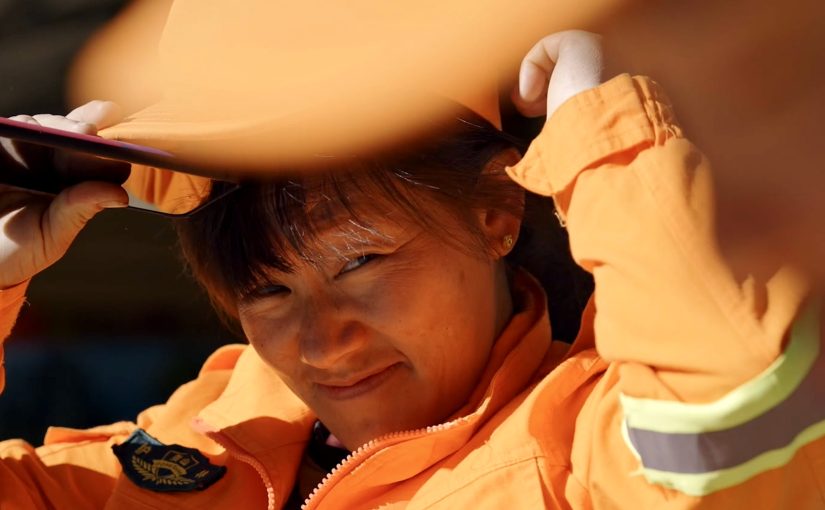
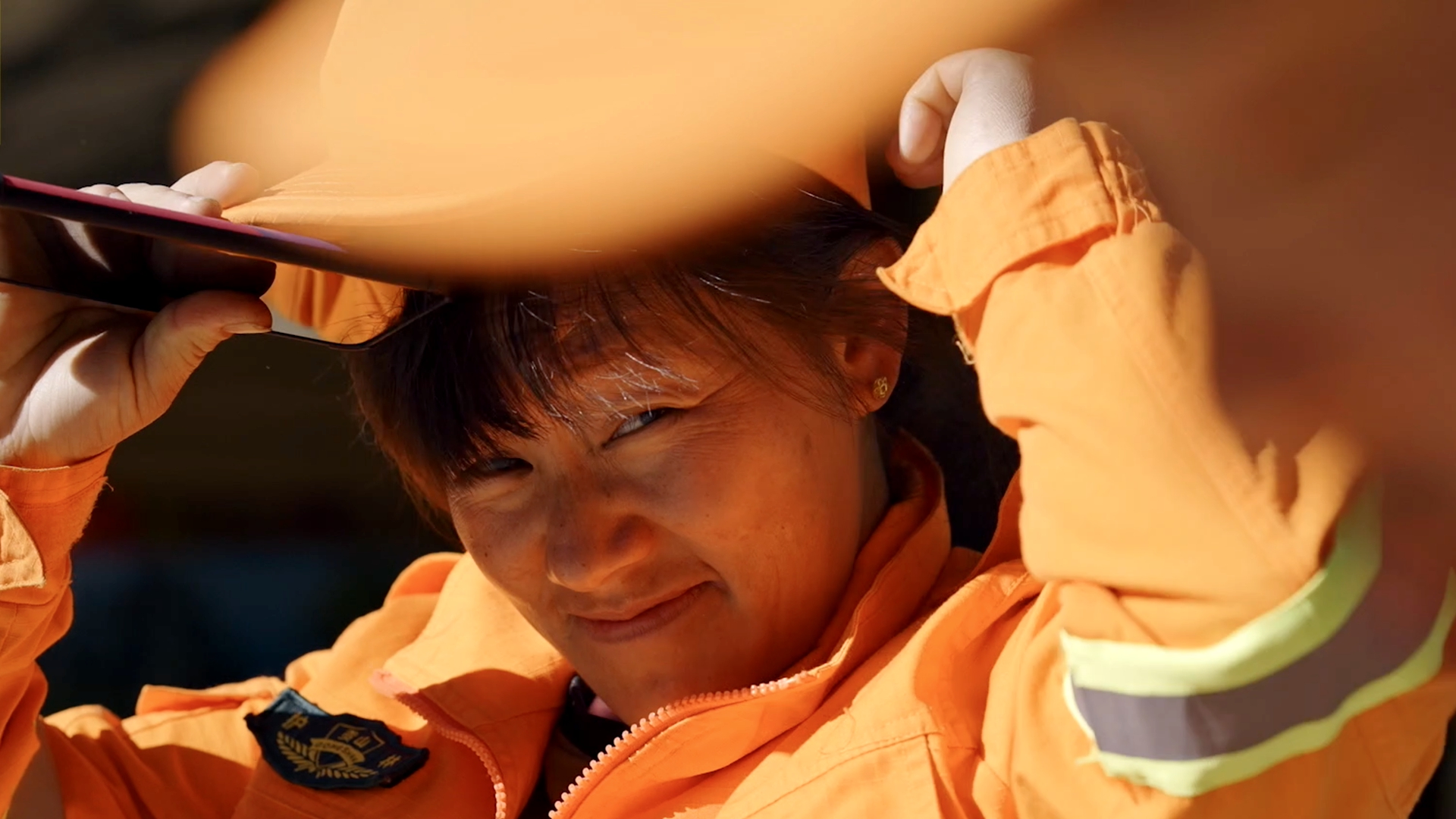 A still from CGTN’s “Journeys in Nature” documentary series shows Li Yuhua, the first female forest ranger among the Drung people in Dulongjiang Township, Gongshan Drung and Nu Autonomous County, Nujiang Lisu Autonomous Prefecture, Yunnan Province, southwest China.
A still from CGTN’s “Journeys in Nature” documentary series shows Li Yuhua, the first female forest ranger among the Drung people in Dulongjiang Township, Gongshan Drung and Nu Autonomous County, Nujiang Lisu Autonomous Prefecture, Yunnan Province, southwest China.  A still from CGTN’s “Journeys in Nature” documentary series shows Liang Zhongjun, a ranger, who patrols twice a day at the Lashihai Plateau Wetland Provincial Nature Reserve in Lijiang City, Yunnan Province, southwest China.
A still from CGTN’s “Journeys in Nature” documentary series shows Liang Zhongjun, a ranger, who patrols twice a day at the Lashihai Plateau Wetland Provincial Nature Reserve in Lijiang City, Yunnan Province, southwest China.  A still from CGTN’s “Journeys in Nature” documentary series shows Li Wenliang (L), a ranger at the Hanma National Nature Reserve in search of the moose, Hulunbuir City, Inner Mongolia Autonomous Region, north China.
A still from CGTN’s “Journeys in Nature” documentary series shows Li Wenliang (L), a ranger at the Hanma National Nature Reserve in search of the moose, Hulunbuir City, Inner Mongolia Autonomous Region, north China. 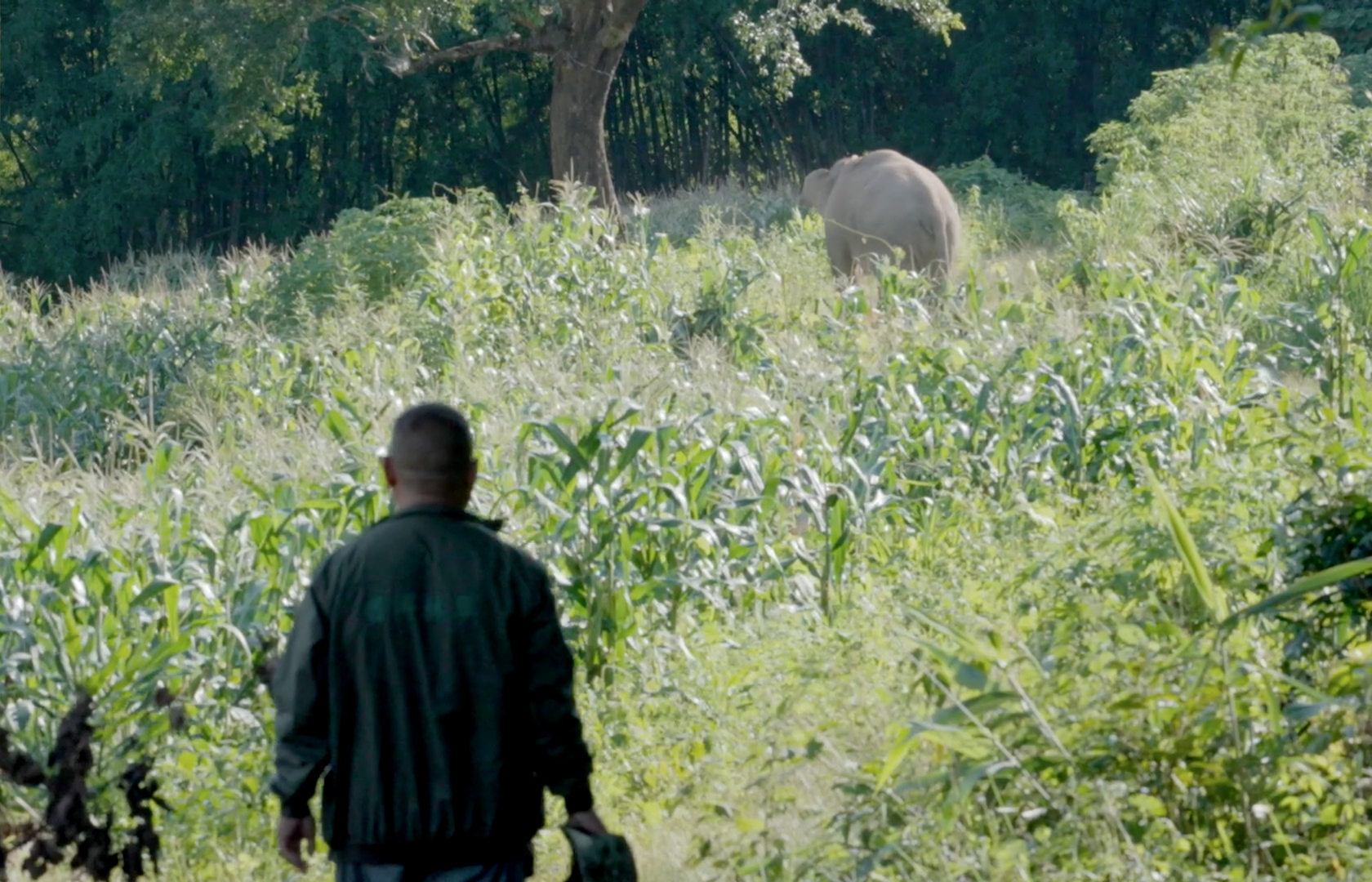 A still from CGTN’s “Journeys in Nature” documentary series shows monitor Diao Faxing with Asian elephants in Pu’er City, Yunnan Province, southwest China.
A still from CGTN’s “Journeys in Nature” documentary series shows monitor Diao Faxing with Asian elephants in Pu’er City, Yunnan Province, southwest China. 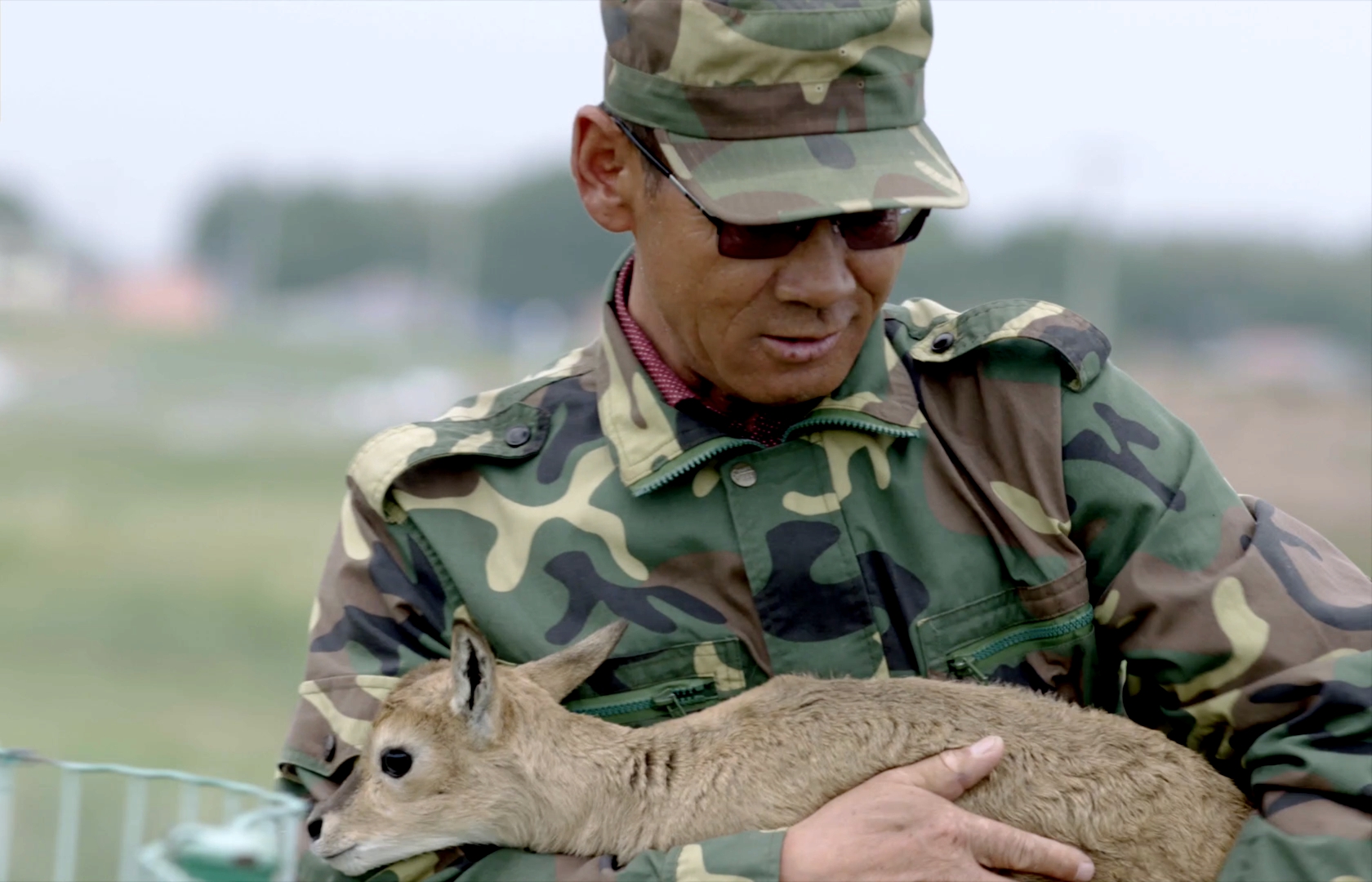 A still from CGTN’s “Journeys in Nature” documentary series shows Wu Yonglin, head of the South Shore Protection Station of Qinghai Lake National Nature Reserve, tending to a Przewalski’s gazelle in Hainan Tibetan Autonomous Prefecture, Qinghai Province, northwest China.
A still from CGTN’s “Journeys in Nature” documentary series shows Wu Yonglin, head of the South Shore Protection Station of Qinghai Lake National Nature Reserve, tending to a Przewalski’s gazelle in Hainan Tibetan Autonomous Prefecture, Qinghai Province, northwest China. 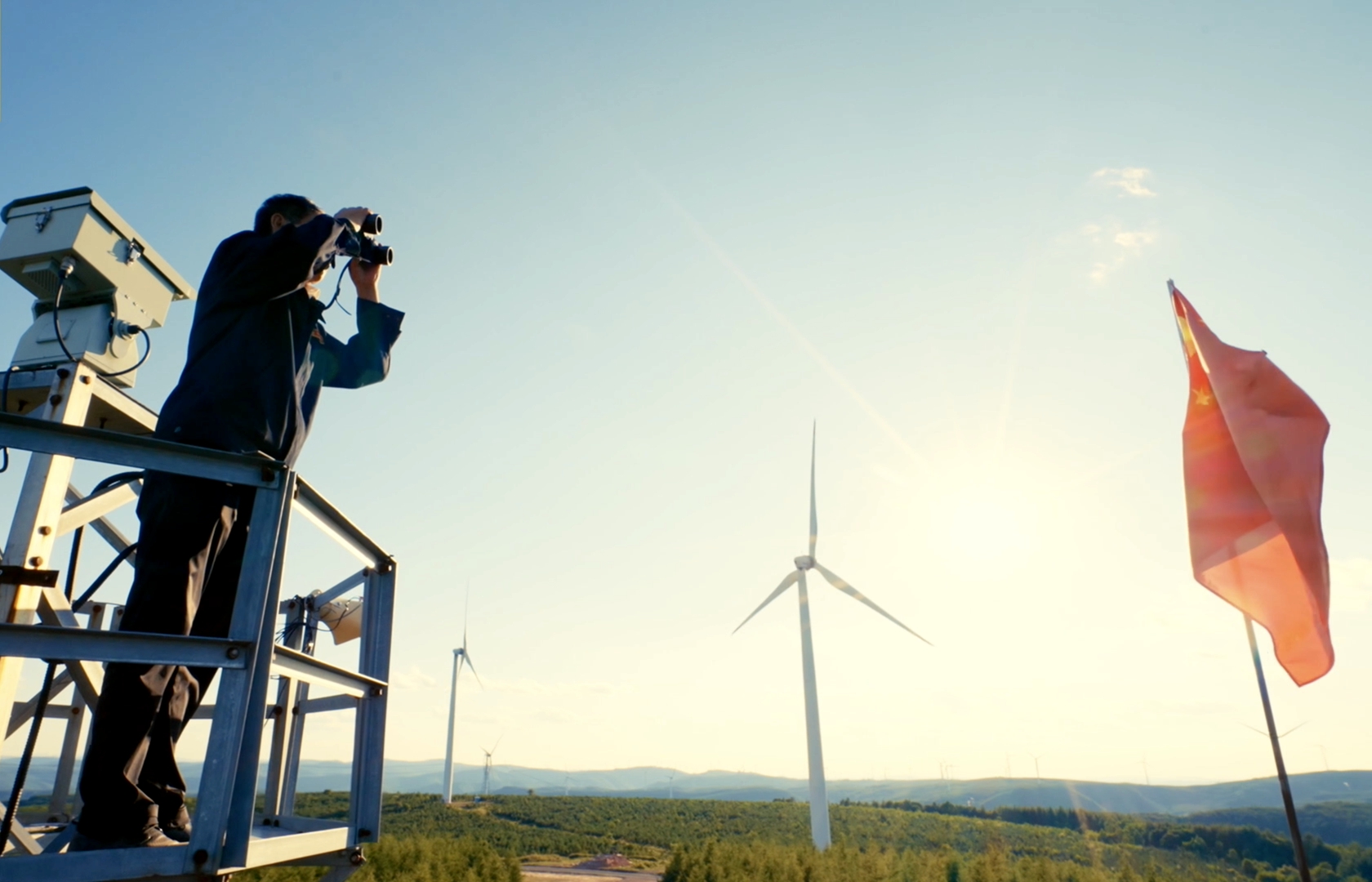 A still from CGTN’s “Journeys in Nature” documentary series shows Zhao Fuzhou, a fire lookout who has secured the Dahuanqi branch of the Saihanba Mechanized Forest Farm for four decades, Chengde City, Hebei Province, north China.
A still from CGTN’s “Journeys in Nature” documentary series shows Zhao Fuzhou, a fire lookout who has secured the Dahuanqi branch of the Saihanba Mechanized Forest Farm for four decades, Chengde City, Hebei Province, north China. 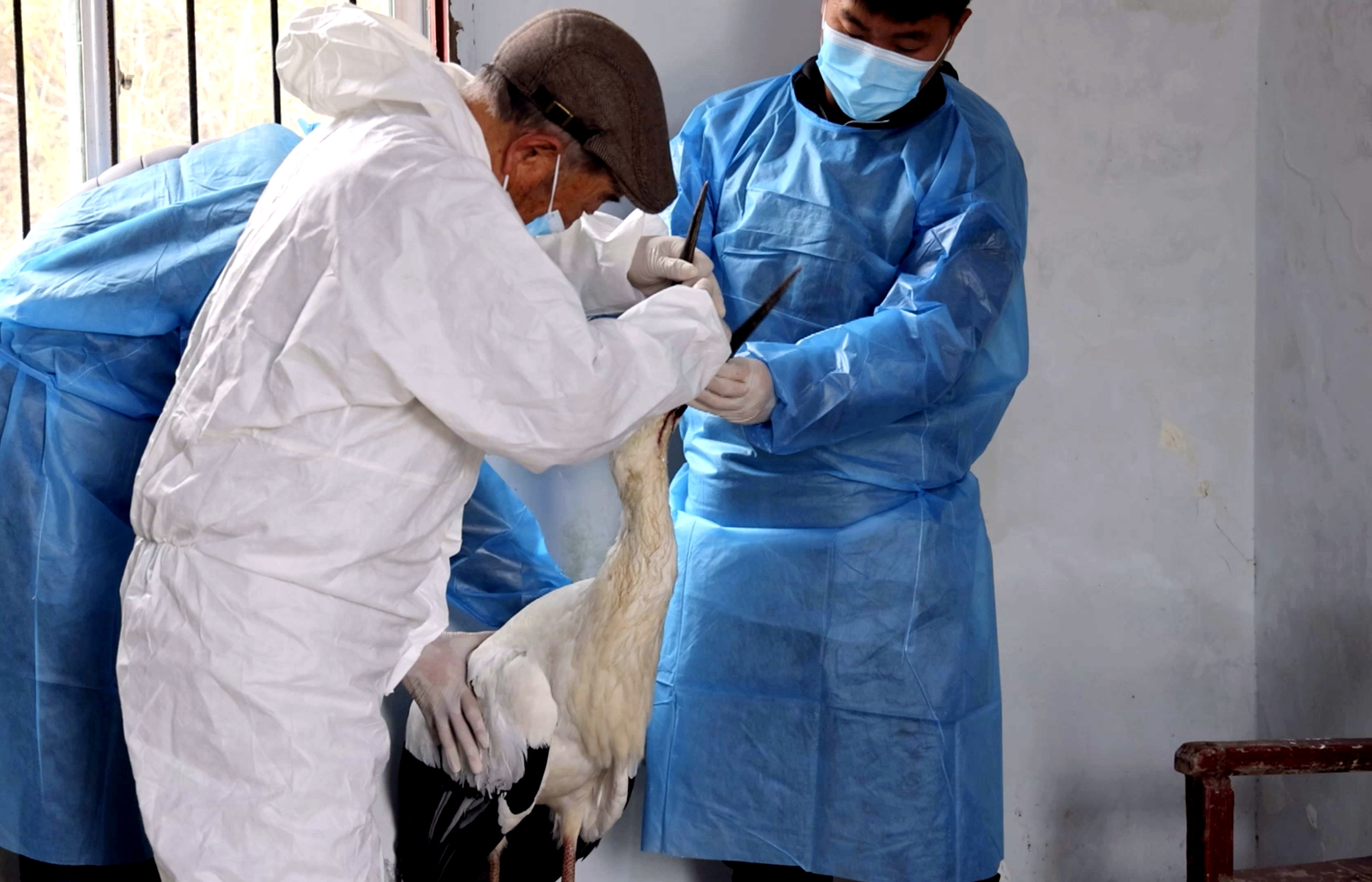 A still from CGTN’s “Journeys in Nature” documentary series shows Li Chunru (L), a vet for migratory birds who has kept a “bird care diary” for 40 years, Jiujiang City, Jiangxi Province, east China.
A still from CGTN’s “Journeys in Nature” documentary series shows Li Chunru (L), a vet for migratory birds who has kept a “bird care diary” for 40 years, Jiujiang City, Jiangxi Province, east China. 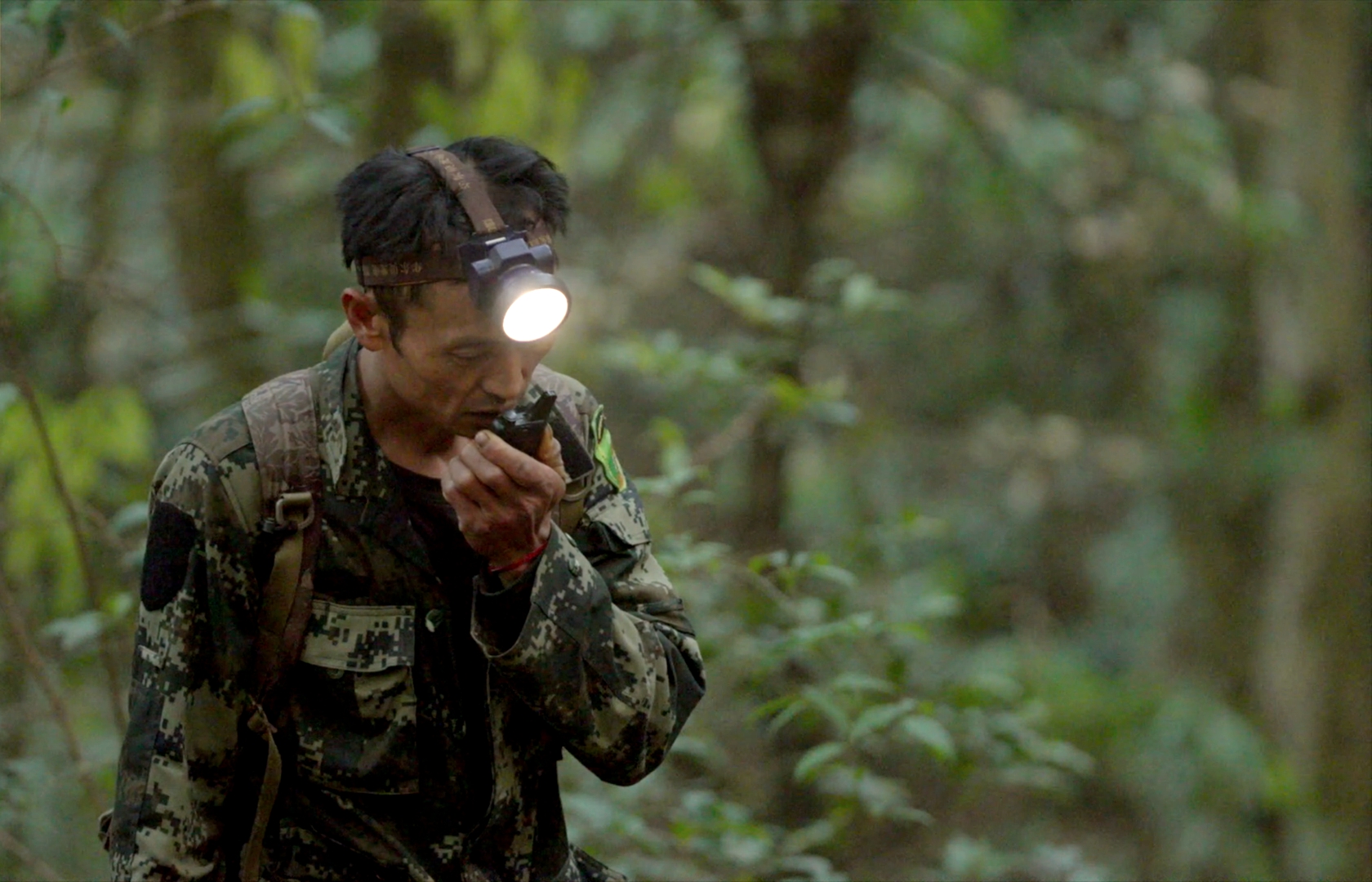 A still from CGTN’s “Journeys in Nature” documentary series shows Xiong Youfu, an observer at Dazhaizi station, looking for the western black-crested gibbon in the Wuliang Mountains in Pu’er City, Yunnan Province, southwest China.
A still from CGTN’s “Journeys in Nature” documentary series shows Xiong Youfu, an observer at Dazhaizi station, looking for the western black-crested gibbon in the Wuliang Mountains in Pu’er City, Yunnan Province, southwest China. 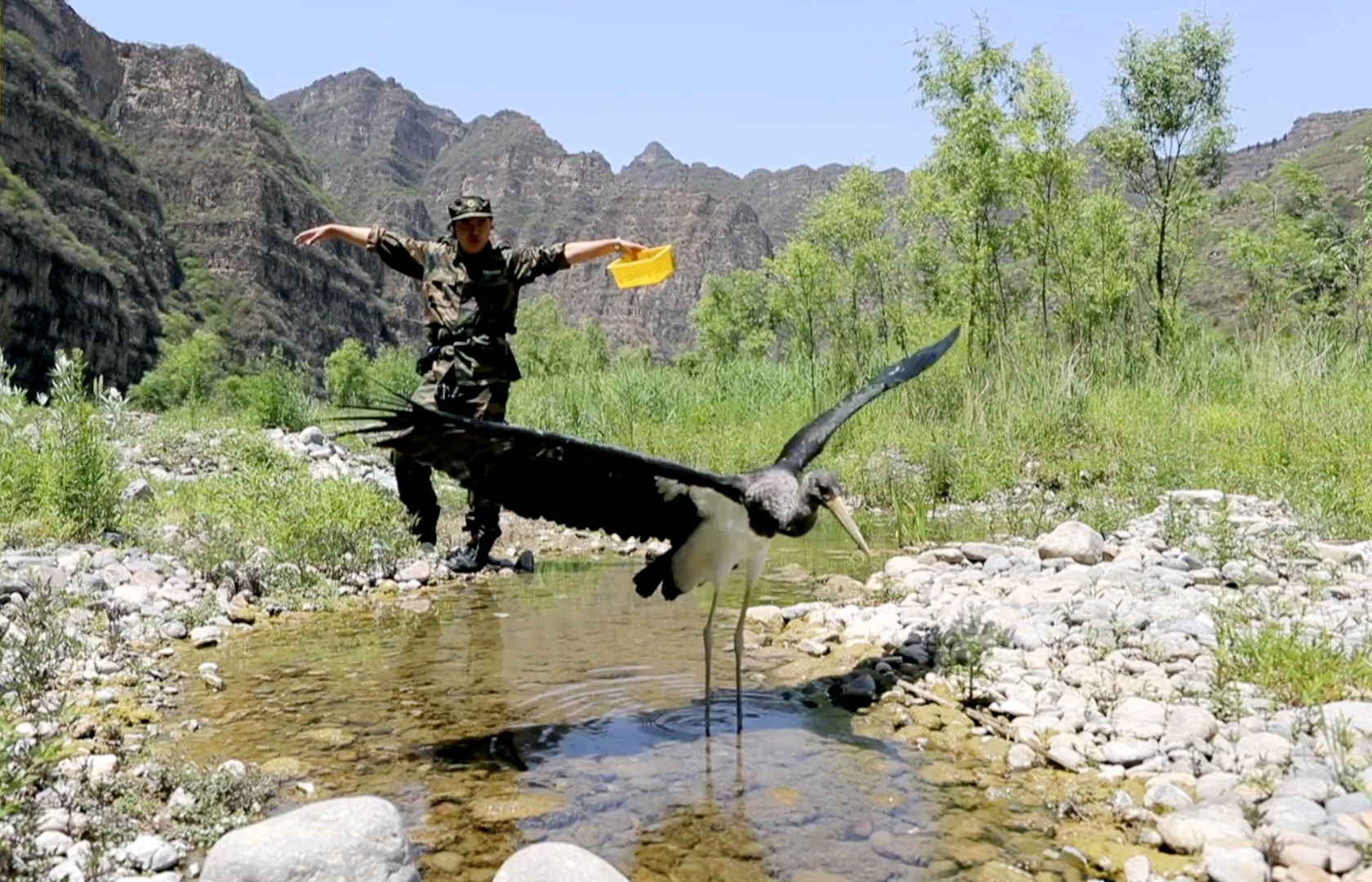 A still from CGTN’s “Journeys in Nature” documentary series shows Li Li, founder of the animal protection NGO Black Leopard Wildlife Protection Center, tending to a black stork, Beijing, China.
A still from CGTN’s “Journeys in Nature” documentary series shows Li Li, founder of the animal protection NGO Black Leopard Wildlife Protection Center, tending to a black stork, Beijing, China. 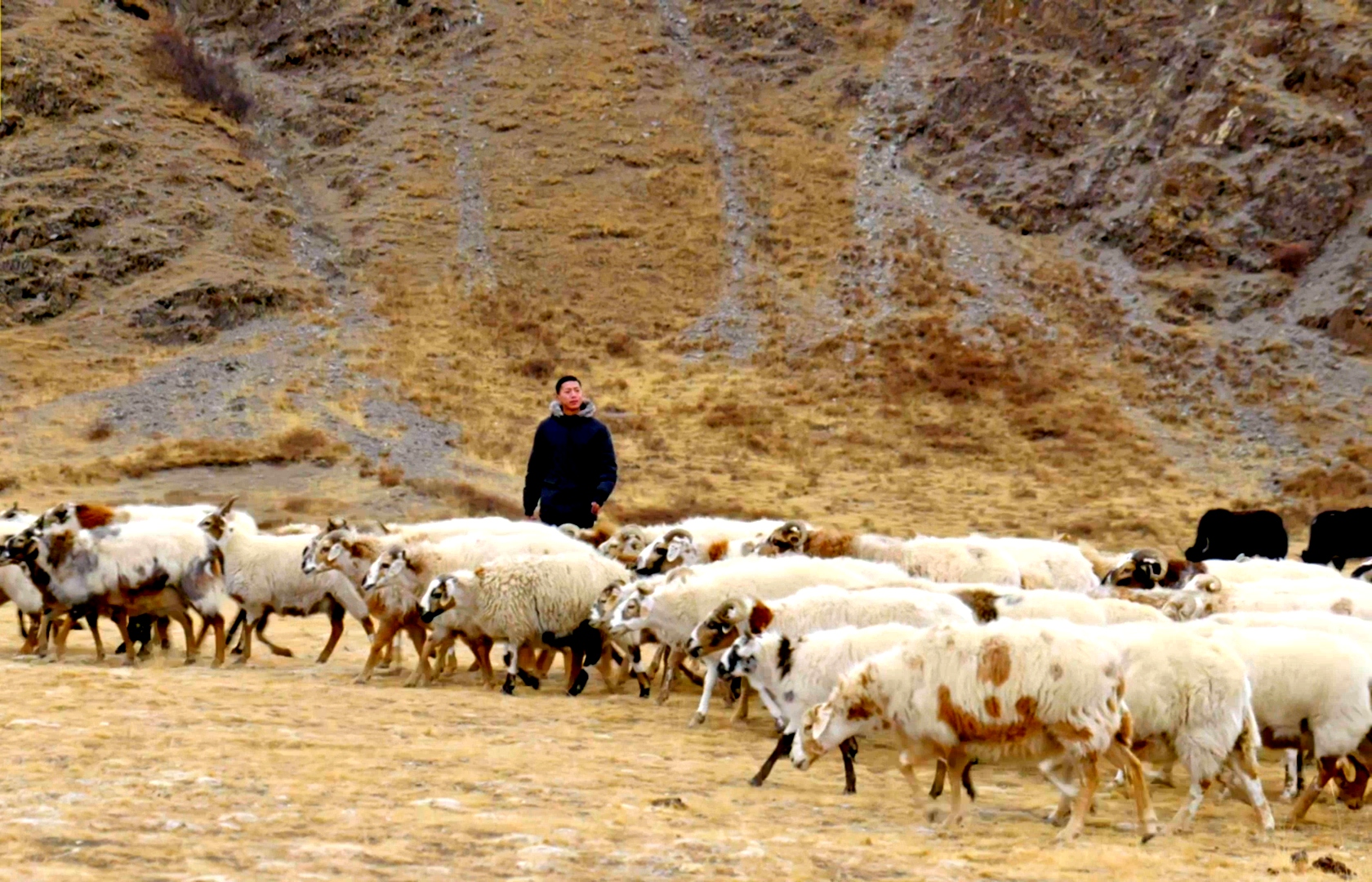 A still from CGTN’s “Journeys in Nature” documentary series shows Jang Tendar, who returned home after graduation and dedicates himself to protecting the ecological environment of Sanjiangyuan area, northwest China.
A still from CGTN’s “Journeys in Nature” documentary series shows Jang Tendar, who returned home after graduation and dedicates himself to protecting the ecological environment of Sanjiangyuan area, northwest China. 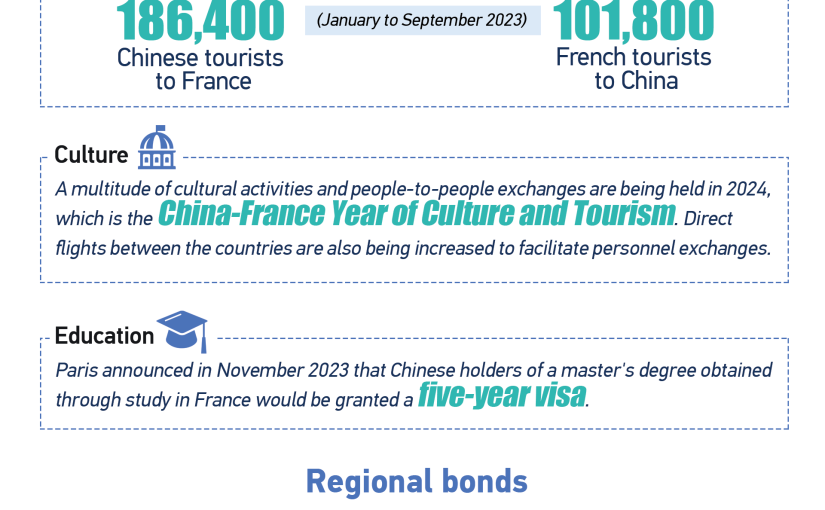


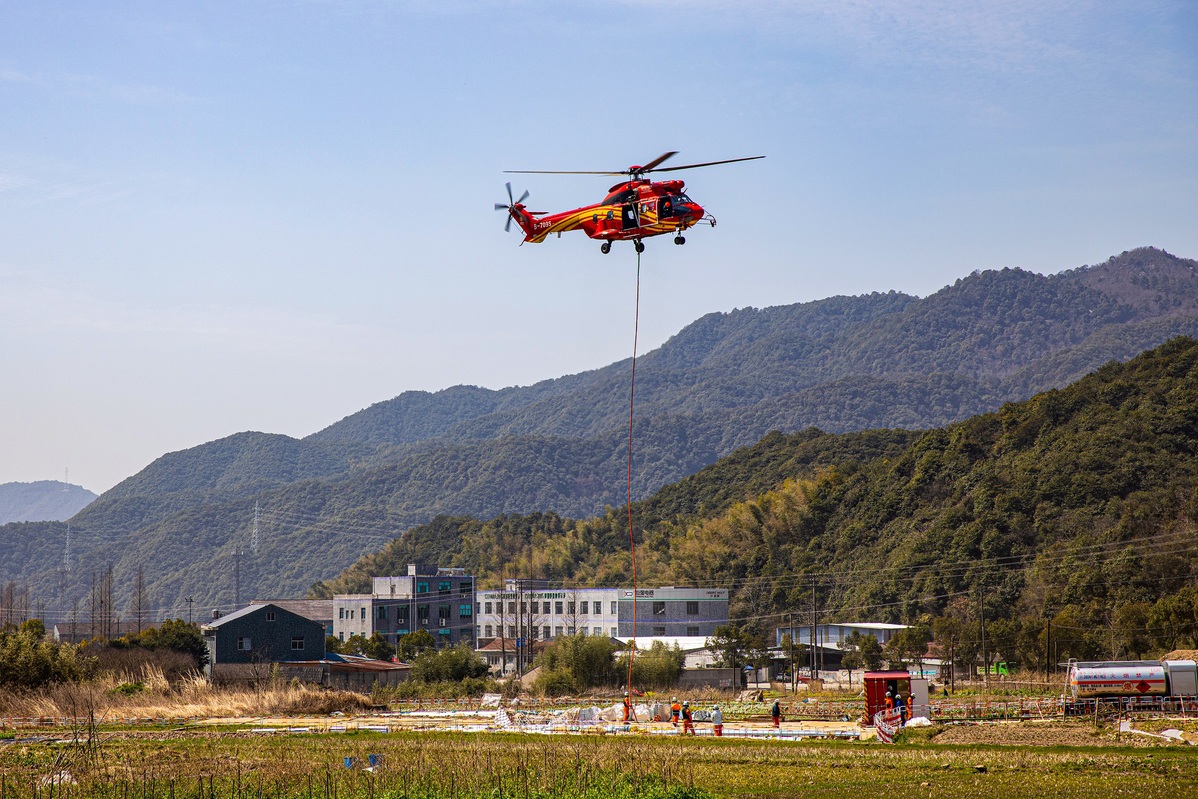 A helicopter carries construction materials to a designated site in Ningbo, Zhejiang province, April 16, 2024. [Photo provided to chinadaily.com.cn]
A helicopter carries construction materials to a designated site in Ningbo, Zhejiang province, April 16, 2024. [Photo provided to chinadaily.com.cn] 
 A special meeting of the World Economic Forum is held in Riyadh, Saudi Arabia, April 28, 2024. /CFP
A special meeting of the World Economic Forum is held in Riyadh, Saudi Arabia, April 28, 2024. /CFP 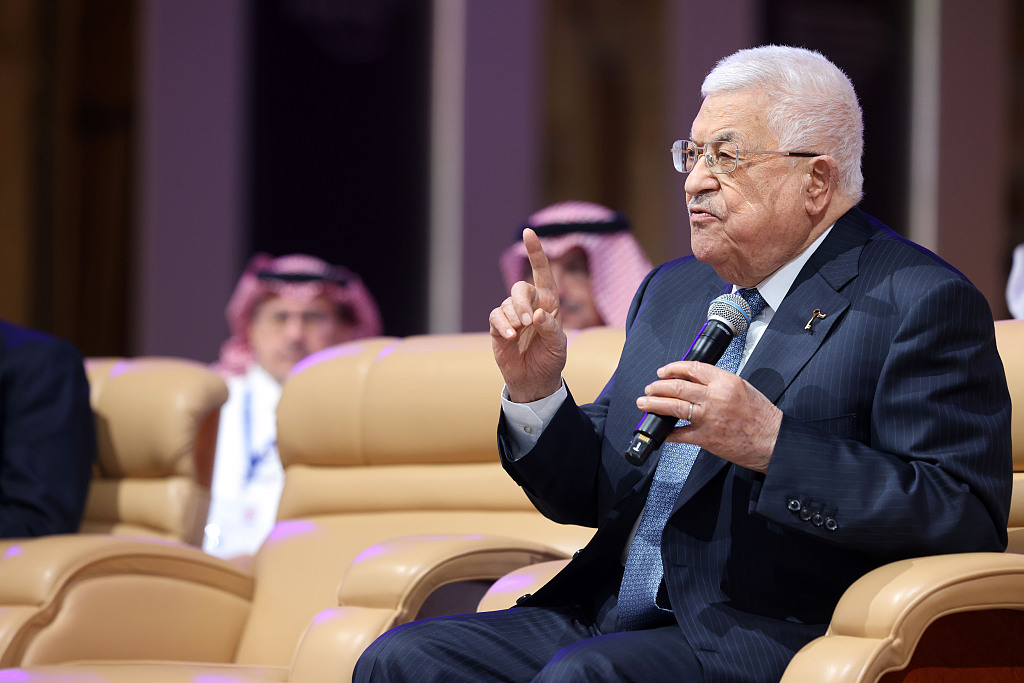 Palestinian President Mahmoud Abbas speaks at a World Economic Forum meeting, Riyadh, Saudi Arabia, April 28, 2024. /CFP
Palestinian President Mahmoud Abbas speaks at a World Economic Forum meeting, Riyadh, Saudi Arabia, April 28, 2024. /CFP 
 The Long March-2F carrier rocket carrying the Shenzhou-17 spacecraft blasts off from the Jiuquan Satellite Launch Center in northwest China, October 26, 2023. /CFP
The Long March-2F carrier rocket carrying the Shenzhou-17 spacecraft blasts off from the Jiuquan Satellite Launch Center in northwest China, October 26, 2023. /CFP  CGTN graphics by Yin Yating.
CGTN graphics by Yin Yating.  The logo of the Shenzhou-17 manned space mission. /China Manned Space Agency
The logo of the Shenzhou-17 manned space mission. /China Manned Space Agency  A send-off ceremony for the Shenzhou-17 crew held at the Jiuquan Satellite Launch Center, October 26, 2023. /CFP
A send-off ceremony for the Shenzhou-17 crew held at the Jiuquan Satellite Launch Center, October 26, 2023. /CFP  The combination of the Shenzhou-17 manned spaceship and a Long March-2F carrier rocket was transferred to the launching area at Jiuquan Satellite Launch Center in northwest China, October 19, 2023. /CFP
The combination of the Shenzhou-17 manned spaceship and a Long March-2F carrier rocket was transferred to the launching area at Jiuquan Satellite Launch Center in northwest China, October 19, 2023. /CFP  The six taikonauts of Shenzhou-16 and Shenzhou-17 hug in the airlock module of the China Space Station. /China Manned Space Agency
The six taikonauts of Shenzhou-16 and Shenzhou-17 hug in the airlock module of the China Space Station. /China Manned Space Agency  Two teams of six taikonauts show thumbs up in the core module of the China Space Station for a group photo. /China Manned Space Agency
Two teams of six taikonauts show thumbs up in the core module of the China Space Station for a group photo. /China Manned Space Agency  The Shenzhou-17 crew conducts extravehicular experimental maintenance, December 21, 2023. /China Manned Space Agency
The Shenzhou-17 crew conducts extravehicular experimental maintenance, December 21, 2023. /China Manned Space Agency  The Shenzhou-17 manned spacecraft docks with the China Space Station, October 26, 2023. /China Manned Space Agency
The Shenzhou-17 manned spacecraft docks with the China Space Station, October 26, 2023. /China Manned Space Agency  The Shenzhou-17 crew celebrate the 2024 Chinese New Year in space. /CMG
The Shenzhou-17 crew celebrate the 2024 Chinese New Year in space. /CMG  The Shenzhou-17 crew eat Chinese dumplings (Jiaozi) to celebrate the 2024 Chinese New Year in space. /CMG
The Shenzhou-17 crew eat Chinese dumplings (Jiaozi) to celebrate the 2024 Chinese New Year in space. /CMG  The Shenzhou-17 crew eat vegetables grown in China’s space station. /CMG
The Shenzhou-17 crew eat vegetables grown in China’s space station. /CMG  The Shenzhou-17 crew get haircuts in space. /CMG
The Shenzhou-17 crew get haircuts in space. /CMG  A view of Earth captured by the Shenzhou-17 crew. /CMG
A view of Earth captured by the Shenzhou-17 crew. /CMG  A view of space captured by the Shenzhou-17 crew. /CMG
A view of space captured by the Shenzhou-17 crew. /CMG  A view of Earth captured by the Shenzhou-17 crew. /CMG
A view of Earth captured by the Shenzhou-17 crew. /CMG 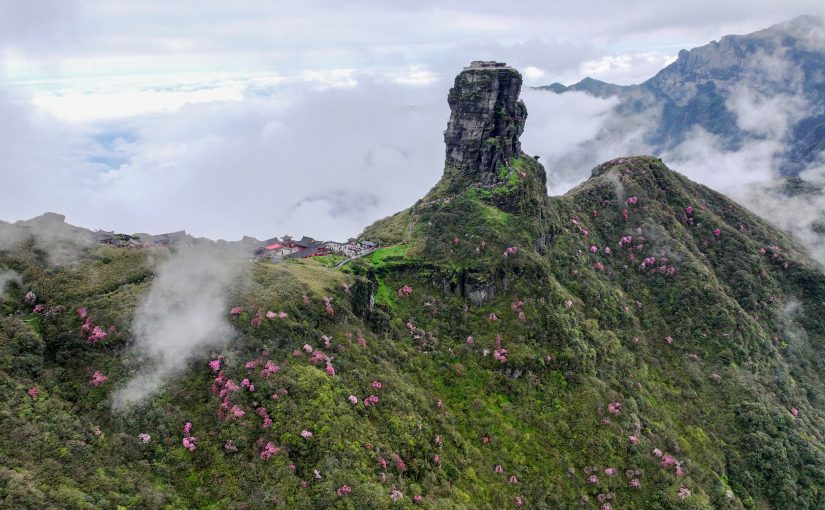
 Blooming azalea flowers adorn Mount Fanjing in southwest China’s Guizhou Province in this undated photo. /Photo provided to CGTN
Blooming azalea flowers adorn Mount Fanjing in southwest China’s Guizhou Province in this undated photo. /Photo provided to CGTN 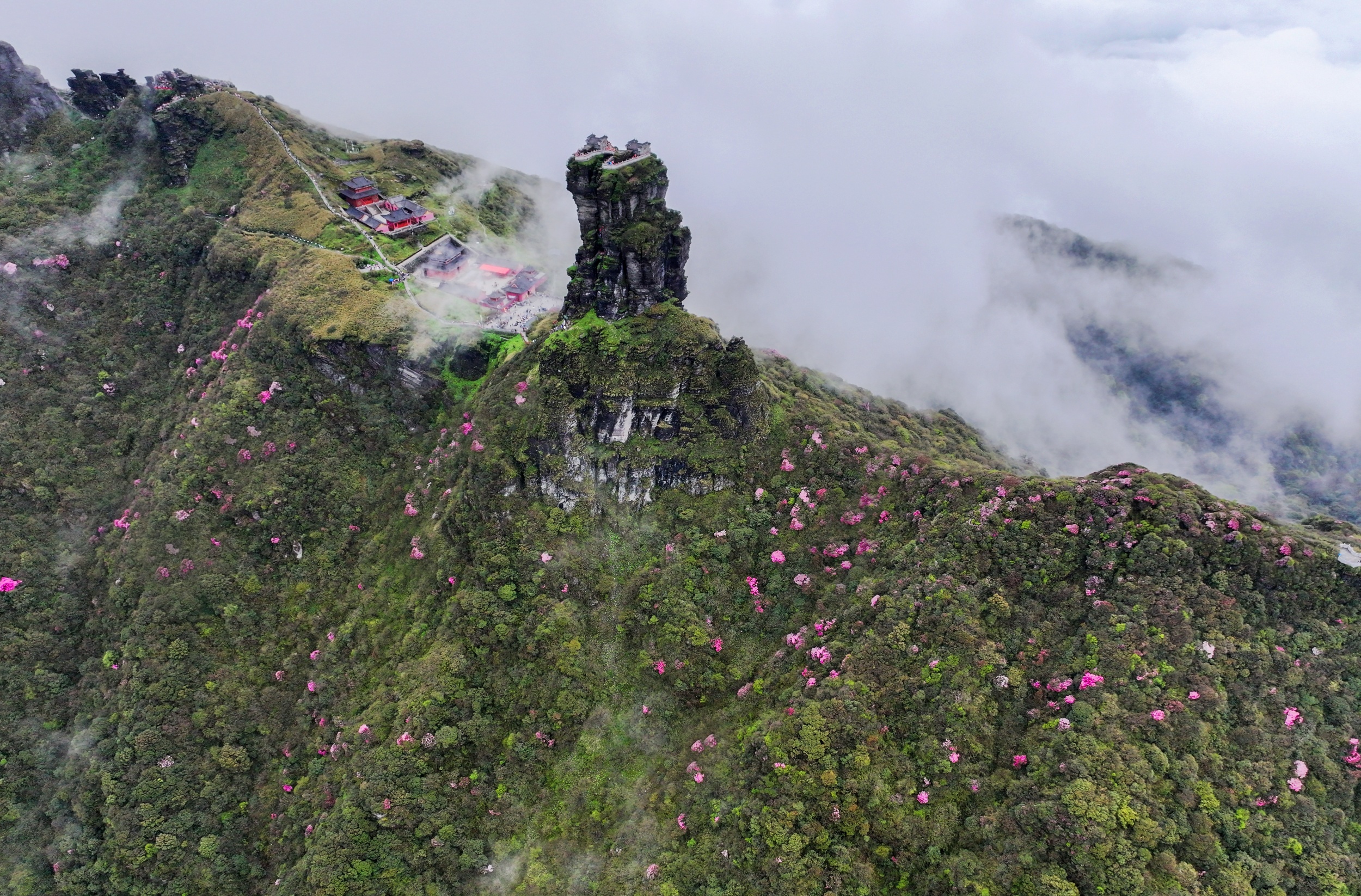 Blooming azalea flowers adorn Mount Fanjing in southwest China’s Guizhou Province in this undated photo. /Photo provided to CGTN
Blooming azalea flowers adorn Mount Fanjing in southwest China’s Guizhou Province in this undated photo. /Photo provided to CGTN  Blooming azalea flowers at Mount Fanjing in southwest China’s Guizhou Province are seen in this undated photo. /Photo provided to CGTN
Blooming azalea flowers at Mount Fanjing in southwest China’s Guizhou Province are seen in this undated photo. /Photo provided to CGTN 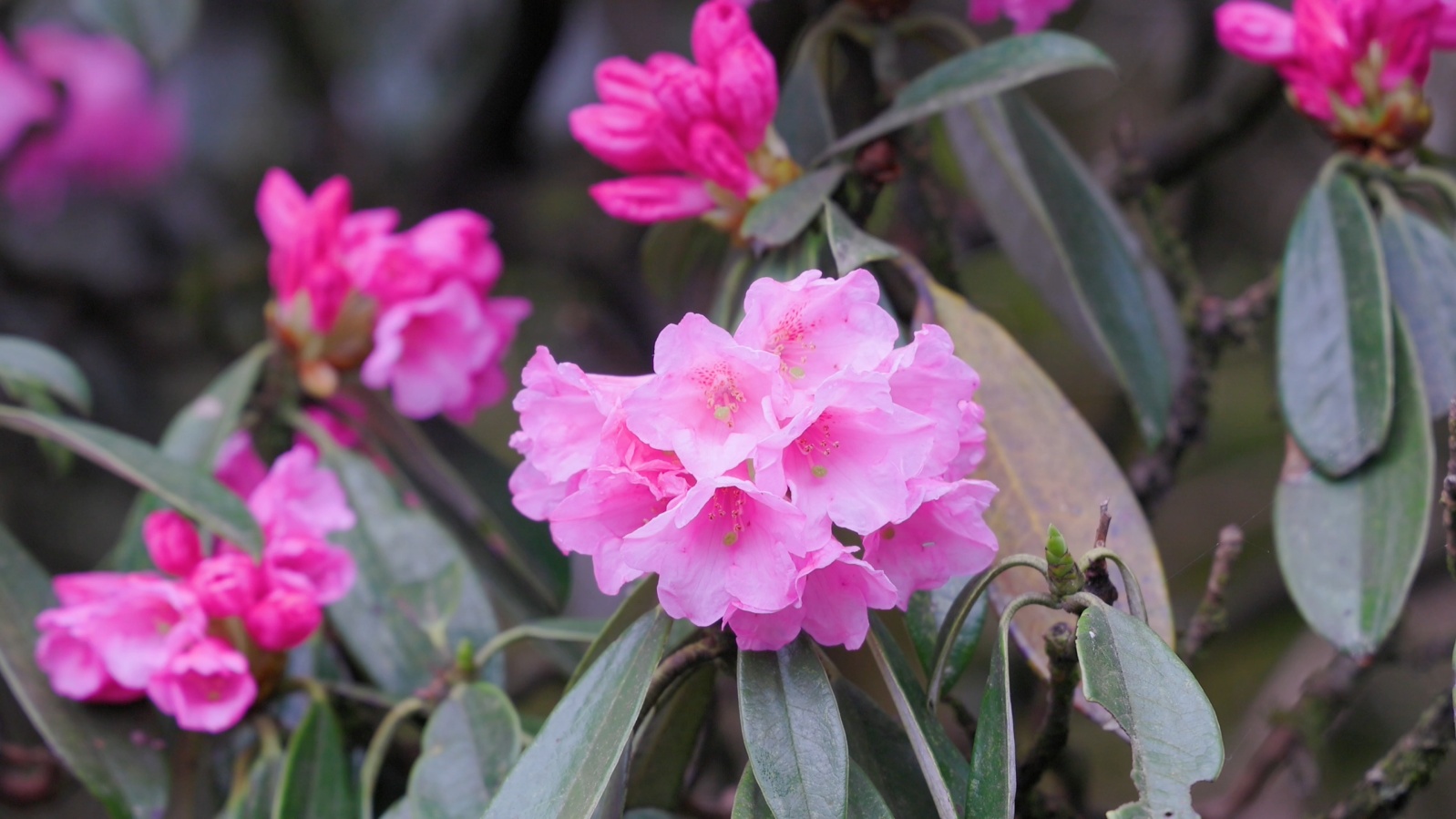 Blooming azalea flowers at Mount Fanjing in southwest China’s Guizhou Province are seen in this undated photo. /Photo provided to CGTN
Blooming azalea flowers at Mount Fanjing in southwest China’s Guizhou Province are seen in this undated photo. /Photo provided to CGTN 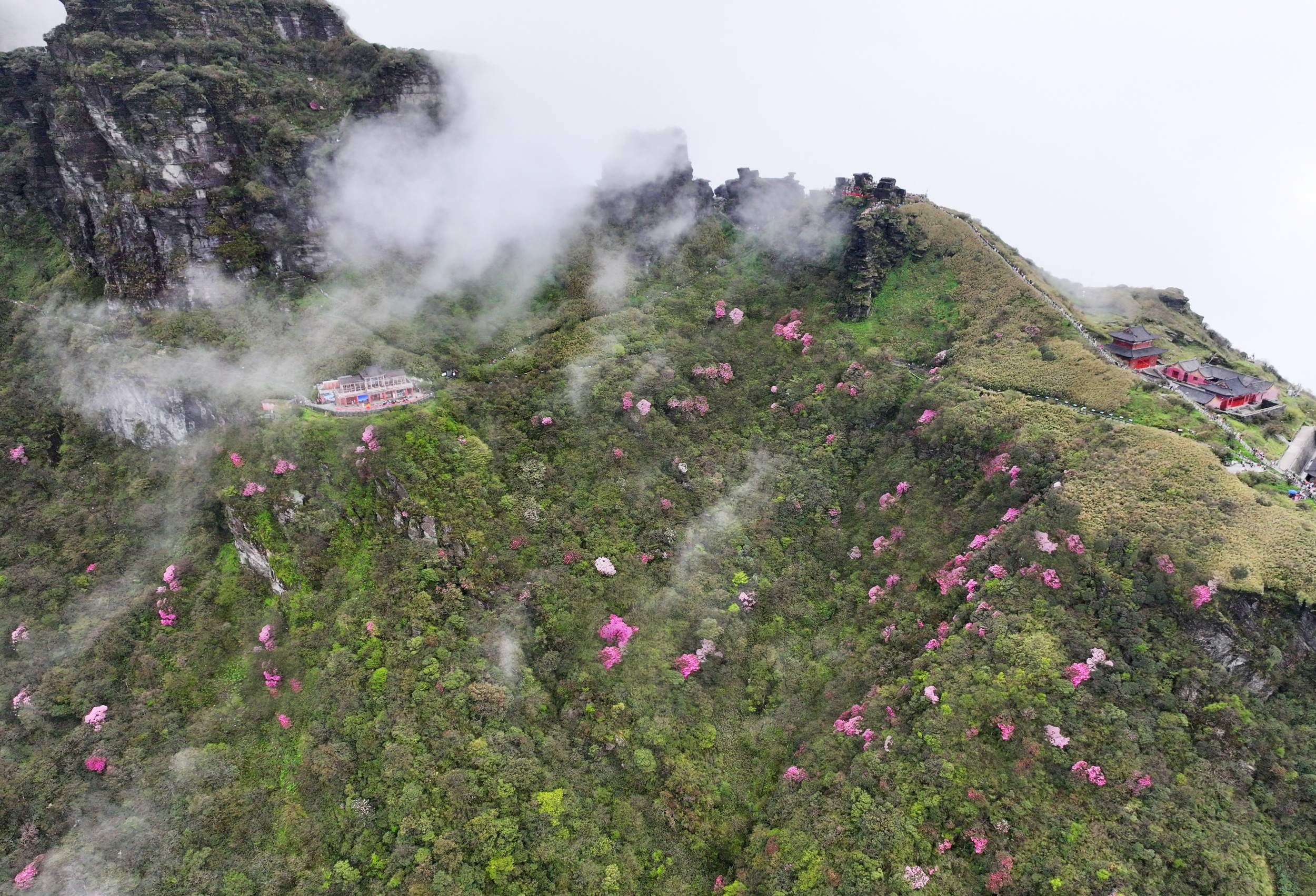 Blooming azalea flowers adorn Mount Fanjing in southwest China’s Guizhou Province in this undated photo. /Photo provided to CGTN
Blooming azalea flowers adorn Mount Fanjing in southwest China’s Guizhou Province in this undated photo. /Photo provided to CGTN 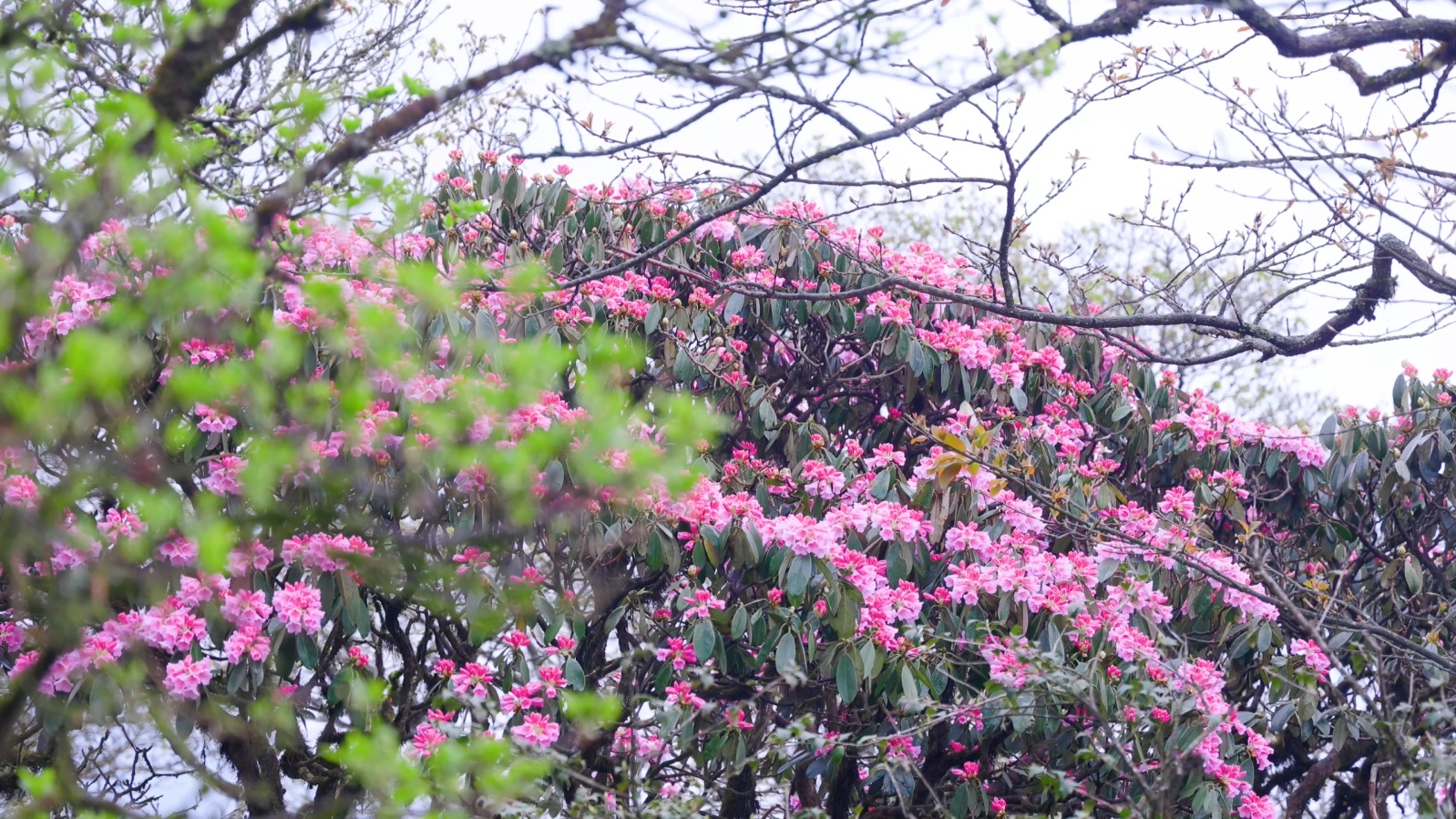 Blooming azalea flowers at Mount Fanjing in southwest China’s Guizhou Province are seen in this undated photo. /Photo provided to CGTN
Blooming azalea flowers at Mount Fanjing in southwest China’s Guizhou Province are seen in this undated photo. /Photo provided to CGTN 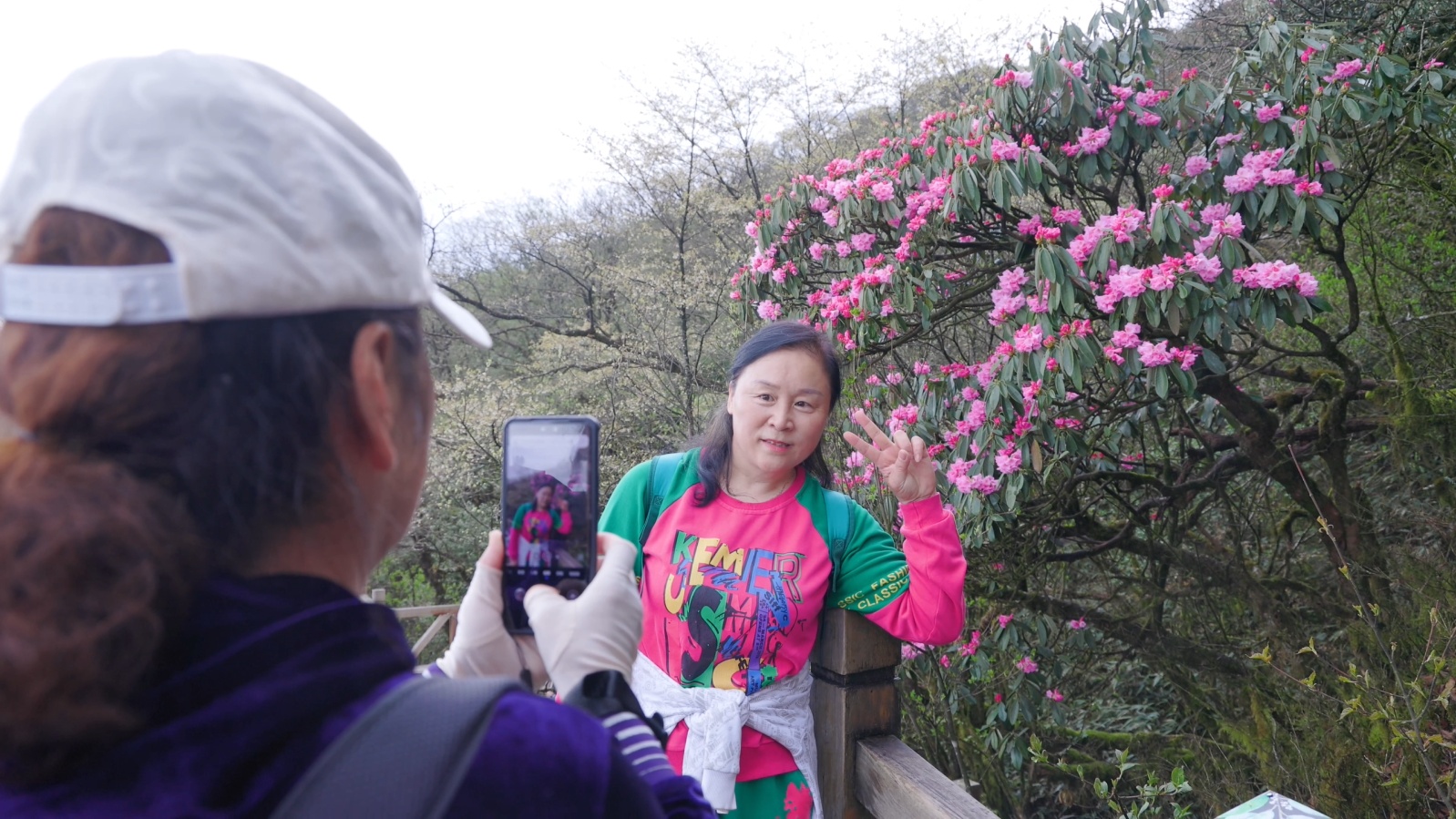 A tourist poses for a photo near blooming azalea flowers at Mount Fanjing in southwest China’s Guizhou Province in this undated photo. /Photo provided to CGTN
A tourist poses for a photo near blooming azalea flowers at Mount Fanjing in southwest China’s Guizhou Province in this undated photo. /Photo provided to CGTN 
 A young woman walks with her pet dog in a pet competition in Beijing, April 14, 2024. Chen Bo/CGTN
A young woman walks with her pet dog in a pet competition in Beijing, April 14, 2024. Chen Bo/CGTN  Pet owners socialize at a “furry-tastic” event in Beijing, April 14, 2024. Chen Bo/CGTN
Pet owners socialize at a “furry-tastic” event in Beijing, April 14, 2024. Chen Bo/CGTN  Handicrafts on sale at a “furry-tastic” event in Beijing, April 14, 2024. Chen Bo/CGTN
Handicrafts on sale at a “furry-tastic” event in Beijing, April 14, 2024. Chen Bo/CGTN  Handicrafts on sale at a “furry-tastic” event in Beijing, April 14, 2024. Chen Bo/CGTN
Handicrafts on sale at a “furry-tastic” event in Beijing, April 14, 2024. Chen Bo/CGTN 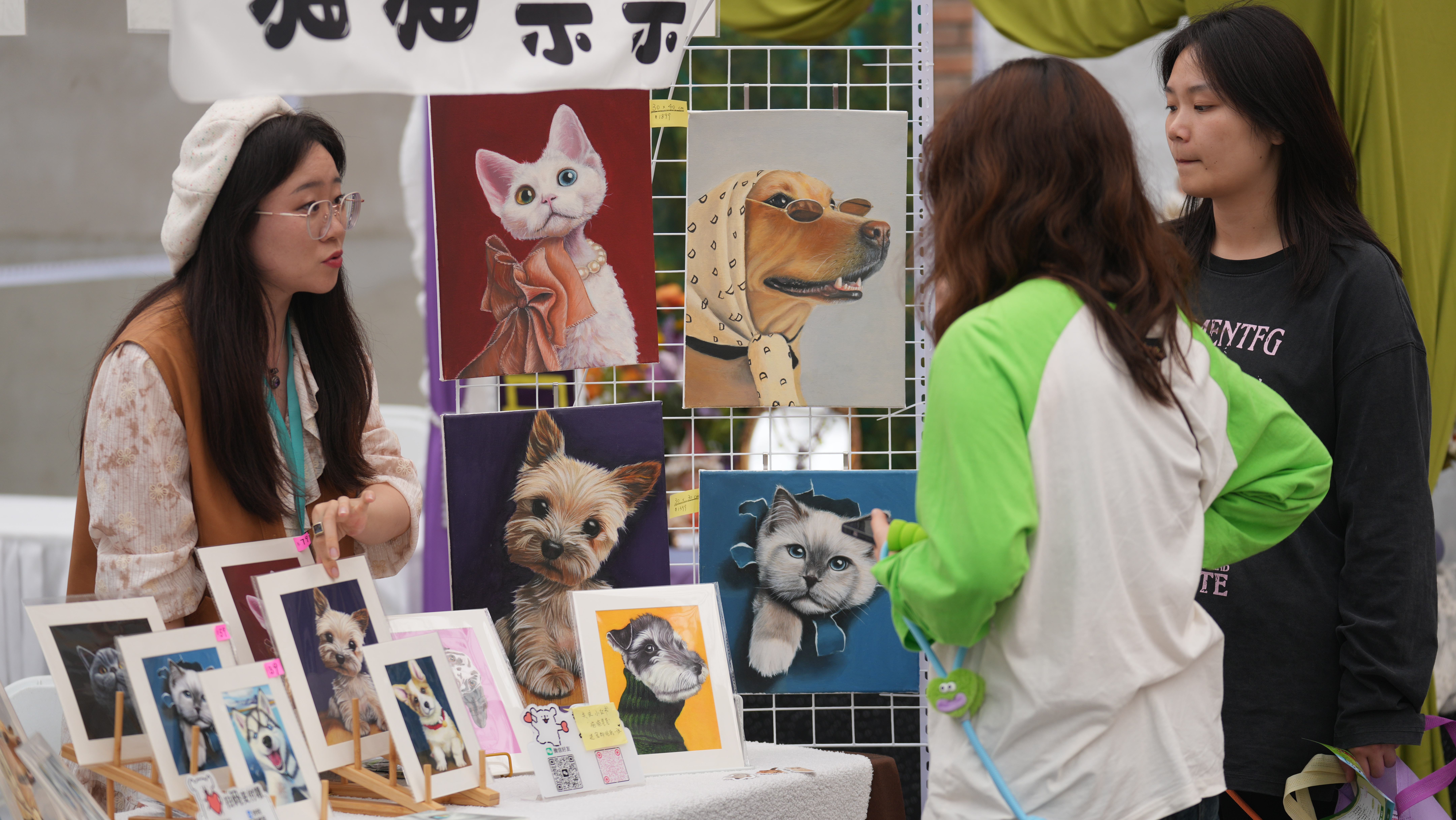 A pet painter showcases her work, April 14, 2024. Chen Bo/CGTN
A pet painter showcases her work, April 14, 2024. Chen Bo/CGTN  A pet dog walks in a competition in Beijing, April 14, 2024. Chen Bo/CGTN
A pet dog walks in a competition in Beijing, April 14, 2024. Chen Bo/CGTN  Pet owners socialize at a pet event in Beijing, April 14, 2024. Chen Bo/CGTN
Pet owners socialize at a pet event in Beijing, April 14, 2024. Chen Bo/CGTN  Pet owners socialize at a pet event in Beijing, April 14, 2024. Chen Bo/CGTN
Pet owners socialize at a pet event in Beijing, April 14, 2024. Chen Bo/CGTN